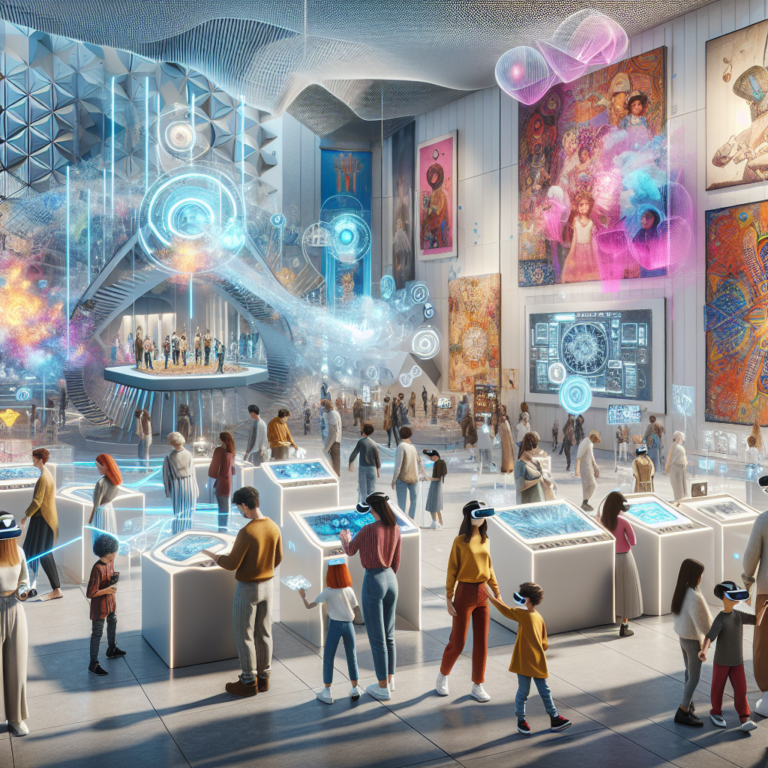Transforming Museum Experiences: The Rise of Immersive Technologies
Engaging Audiences with Interactive Innovations
Museums worldwide are evolving, shifting from traditional exhibition halls to dynamic interactive spaces aimed at captivating audiences. With the incorporation of modern technologies, visitors are no longer passive observers but active participants in the storytelling process. This transformation has made museums more appealing, ensuring they resonate with a wider demographic, including families, school groups, and tech-savvy millennials.
Immersive Experiences: Examples to Inspire
Some standout examples of immersive experiences in museums include:
- Wake The Tiger: A creative installation that invites participants to journey through an enchanting world, blending art and nature.
- Oasis Immersion: An experiential space designed to engage visitors through vivid storytelling and sensory interaction.
- Area15: A unique entertainment complex showcasing immersive art installations, virtual reality segments, and interactive experiences.
These innovative projects exemplify how museums can use immersive technologies to enhance visitor engagement while creating unforgettable memories.
Harnessing Technology for Enhanced Visitor Experiences
To bring exhibits to life, museums are increasingly utilizing cutting-edge technologies such as:
- Augmented Reality (AR): This technology overlays digital information onto the real world, providing layered context to artifacts and historical narratives.
- Virtual Reality (VR): Allows visitors to step into different times and spaces, facilitating exploration of historical events or distant cultures.
- Digital Exhibitions: Interactive displays that can be accessed online, opening museum doors to global audiences.
- Touchscreen Displays: Enabling personalized interactions and deeper dives into specific topics of interest.
- Holographic Displays: Offering a mesmerizing visual representation of exhibits that captivate and educate.
- Gamification Elements: Incorporating game-like features to make learning fun and engaging.
Real-World Applications of Immersive Technologies
Let’s explore prominent museums that have embraced these immersive solutions to enhance their visitor experiences:
- Meet Vincent Van Gogh: An innovative experience that immerses visitors in the life and works of the renowned artist through technology and art.
- The National Museum of Singapore: A vibrant hub that integrates AR elements into its exhibits, offering rich storytelling experiences.
- The Cleveland Museum of Art: This institution employs VR and AR technology to enhance visitor engagement and understanding of their collections.
Each of these museums illustrates the power of technology in transforming traditional perceptions of art and history.
The Emerging Trend of Online Exhibitions
In recent years, online exhibitions have surged in popularity, allowing museums to reach audiences far and wide. These digital experiences provide:
- Interactive Experiences: Visitors can engage with artifacts and stories from the comfort of their homes.
- Greater Accessibility: People from different regions can access exhibitions that would otherwise be geographically or financially out of reach.
- Innovative Technology Utilization: Many online exhibits use AR and VR features to create captivating digital journeys.
By offering online exhibitions, museums are breaking down barriers and making cultural experiences inclusive for all.
A Paradigm Shift in Museum Culture
The adoption of immersive technologies represents a significant paradigm shift in museum culture. This shift is not only attracting more visitors but also personalizing their experiences. Benefits of this transformation include:
- Personalization: Immersive experiences allow visitors to tailor their journeys and explore their interests.
- Increased Visitor Engagement: Dynamic installations captivate audiences, encouraging longer visits and deeper connections.
- Enhanced Learning: When technology meets storytelling, the possibility of meaningful learning increases dramatically.
Expanding Perspectives: The EMOTIVE Project
The EMOTIVE project, developed by researchers at the University of York, exemplifies the impressive potential of immersive storytelling. This initiative focuses on enhancing historical site experiences, such as:
- York Minster: Implementing digital storytelling and VR technologies to reconnect visitors with history.
- Çatalhöyük in Turkey: An archaeological site benefitting from innovative storytelling techniques.
- The Antonine Wall in Scotland: Integrating modern technology to engage visitors in the area’s rich heritage.
Dr. Sara Perry, a key researcher, emphasizes the significance of digital storytelling, which encourages users to draw parallels between their current values and those of the past, making history more relatable and enjoyable.
The Role of Augmented Reality in Cultural Preservation
While immersive technologies significantly enhance visitor engagement, they also aid in cultural preservation. For instance, AR applications:
- Bring Lost Artifacts to Life: Allowing visitors to see what the artifacts once looked like in their original contexts.
- Offer Guided Tours: Providing an enriched narrative and additional context to exhibits, helping to foster a deeper understanding.
- Encourage Customized Experiences: Tailoring the visit according to the preferences of different audiences.
Exploring the Future of Museum Technologies
As technological advancements continue to reshape the landscape of museum experiences, institutions face both challenges and opportunities. Key considerations for museums looking to adopt these technologies include:
- Costs: Balancing budgets while implementing exciting new tech can be daunting.
- Hygiene Concerns: Ensuring that shared technologies are safe and clean for all visitors.
- Visitor Comfort: Minimizing simulation sickness by offering comfortable and easily navigable setups.
Yet, as evidenced by projects such as the Kremer Museum—a virtual space showcasing art collections—there is tremendous potential to enhance accessibility for audiences with mobility issues and to provide global access to collections.
Conclusion
Immersive technologies are rapidly reshaping the museum experience, ensuring that history and culture are not only preserved but also made vibrant and engaging for all visitors. As museums continue to innovate and adapt, the future looks bright for cultural institutions, ensuring they remain relevant in a rapidly changing world. 🌍




0 Comments